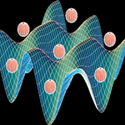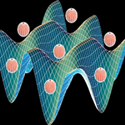Hubbard model for ultracold atoms
Ultracold atoms stored in optical lattices are a highly controllable way to study systems of strongly correlated particles, offering the possibility of better understanding key phenomena in condensed matter physics. On the condensed matter side, a key tool in every researcher’s kit is the Hubbard model, which was developed in the 1960s to investigate the insulating and conducting states of electrons in solids. This model consists of particles on a lattice, in which the Hamiltonian combines an on-site energy and a “hopping” term to account for tunneling from site to site. Now, in a paper in Physical Review Letters, Hans Peter Büchler of the University of Stuttgart, Germany, reports an analysis of the Hubbard model for two ultracold atoms moving through an optical lattice trap.
In Büchler’s work, the two particles interact through a Feshbach resonance that allows the interaction to be tuned all the way from attraction to strong repulsion. For atoms in a three-dimensional lattice, the author is able to exactly calculate the bound-state energies and band structure and compare with predictions of the Hubbard model. As the interaction strength increases, however, the Hubbard picture deviates more and more from the exact solution, a finding that will be important as experimental efforts seek to observe ordered magnetic and superconducting phases in the strongly interacting regime. – David Voss





